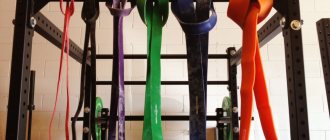Pull-ups, with each new trend in fitness, are becoming more common, despite their established popularity. Whatever sport is in fashion - workout or crossfit, pull-ups are always an integral part of sports disciplines. The standard for pull-ups, for example in CrossFit, is to perform a large number of pull-ups in the shortest possible period of time.
How to increase the number of pull-ups on the horizontal bar
Over time, any load goes through an adaptation stage, during which the muscles get used to the movements and begin to perform their tasks much easier. Obviously, the more and longer you do pull-ups, the number of pull-ups will increase over time. How to speed up this process?
To begin with, you need to decide on a training regimen so that the muscles have time to recover, but also do not lose their shape. For a large number of pull-ups, you can train 2-3 times a week , it is advisable to conduct functional training to develop endurance of all muscle groups.
If you train the back with the pectoral muscles, you can increase strength faster, since the coordinated work of antagonist muscles is more likely to prepare the body for a large number of pull-ups than isolating strength work on individual muscles.
INCREASE THE NUMBER OF PULL-UPS
There are several ways. All of them have been tested by time and many generations of athletes. For example, there is a simple method called the “reverse staircase”. This training method consists of performing 4 approaches. During the first approach, the athlete pulls himself up as many times as possible. On the next approach, perform one less pull-up. And so on. Rest between repetitions is about 3 minutes.
Here's an example. Let's say an athlete does 10 pull-ups (the average number for a normally developed man), but wants to show a more impressive result. Then he begins to train as follows:
- The first approach is 10 times.
- The second approach is 9 times.
- Third approach - 8 times.
- The fourth approach is 7 times.
After training like this for some time, a person begins to notice that 10 times is no longer the limit. The number of pull-ups is growing.
Techniques for increasing pull-ups
Negative load
Pull-ups are the dynamic work of long muscle fibers that are stressed during the contraction (tension) phase. Negative loading involves maintaining muscle tension while relaxing , that is, the muscles will work harder when lowering the torso than when pulling up. This technique will quickly increase the number of pull-ups.
Static load
In addition to long fibers, short (slow) fibers must work, which will be activated under static load. For complex muscle development, it is necessary to “awaken” these fibers that do not participate in dynamics. To do this, you need to perform “hangs” - pauses at the top point of the pull-ups. You can pull yourself up to the bar, freeze for a few seconds, and then slowly straighten your elbows. This technique will allow all fibers to be put into operation at the same time.
Inertia
Gymnasts and crossfitters use swinging techniques, which, due to inertia, lighten the load and increase the number of pull-ups. Perform several body swings and, as you move forward, jerk yourself up to the bar , exhale, relax your arms as you inhale, and continue to pull yourself up by inertia.
Additional load
Constant progress and overcoming the load develops muscle strength, which is very important when increasing the number of pull-ups on the horizontal bar. If you have stopped making progress and the number of pull-ups is not increasing, add weights and perform pull-ups “for strength”. After a while, after strength training, do pull-ups with your own weight. The number of repetitions will increase noticeably, since the muscles have overcome a greater load, which means they have gained strength.
What is important for training on the horizontal bar
Quality is more important than quantity
Many horizontal bar lovers increase the number of pull-ups at the expense of losing the quality of the exercises. Pull-ups are often performed by rocking or jerking. This is the wrong training tactic, since the development of physical qualities will not occur - rather, the process of degradation will begin.
Many repetitions are carried out not because the muscles strengthen and become stronger and more resilient, but due to cheating . We are talking about the use of rocking and jerking, and this will not help in sports. Such repetitions will not count towards pull-ups. The exception is CrossFitter competitions, where the athlete needs to complete as many repetitions as possible, and no matter in what way.
To learn how to do pull-ups many times and still benefit the body, you need to perform exercises with clean technique. If you break it, you can set some kind of record, but it will not bring physical results.
When doing pull-ups, consider the following:
- you can't swing;
- you need to pull yourself up smoothly, without jerking;
- the chin should be above the bar not due to neck extension, but due to the work of the latissimus dorsi muscles.
These are three unshakable rules that must be followed for the correct technique of performing exercises. What's the point of lifting your body 50 times if it doesn't produce results? There are exercises that are performed in jerks, which is necessary to develop explosive strength, but such methods are not suitable for regular training.
Strength of will
To achieve an increase in pull-ups on the horizontal bar, you need to put in a lot of effort and patience , since this process is long. Every day you need to force yourself to go to training. No technique will help you increase the number of pull-ups in the shortest possible time; the result will be achieved only after many difficult weeks. You need to take the training process seriously and not panic if the result is not achieved after a few days. The muscles are trained gradually - you just need to tune in to the sports regime and not give up training.
Pull Up Program
First week:
- day – negative pull-ups for the maximum number of repetitions (4-6 sets).
- day – static load to the maximum (4-6 approaches).
- day – pull-ups by inertia to the maximum (4-6 approaches).
Second week:
- day – negative pull-ups for 4-6 approaches (+ 1-2 repetitions).
- day – static load for a maximum of 4-6 approaches (+ 1-2 repetitions).
- day – pull-ups by inertia for a maximum of 4-6 approaches (+ 1-2 repetitions).
Third week:
- day – negative pull-ups for 4-6 approaches (+ 1-2 repetitions for the results of the second week).
- day – static load for a maximum of 4-6 approaches (+ 1-2 repetitions for the results of the second week).
- day – pull-ups by inertia for a maximum of 4-6 approaches (+ 1-2 repetitions for the results of the second week).
Fourth week:
Strength training (2 training days) – work with additional weights. Perform the maximum number of pull-ups in 4 sets.
The second month of training begins according to the scheme of the first week with more repetitions compared to the first month, and so on, adding 1-2 repetitions every week.
Pull Up Program
It's definitely a very specific program. It is designed for five workouts per week, and I recommend sticking to the schedule for 5-6 weeks. You can choose any five days of the week, but be sure to exercise every day. Then two days of rest, and again everything from the beginning.
Armstrong trained from Monday to Friday and rested on the weekends. But he didn't just pull himself up. Every morning he did three maximally heavy sets of push-ups. This made it possible to maintain the balance of the muscles responsible for presses (chest, triceps).
This program focuses on the muscles responsible for pulling (biceps, back). The total rest time between sets is somewhere between 5 and 10 minutes.
The rest is an endless series of stretches. But here it is important to clarify: you need to do pull-ups cleanly, according to all the rules of technique. This means that you need to overcome the entire range of motion without jerking or jerking your legs, and not somehow reach your chin to the bar. Everything needs to be done beautifully and under control, and if you can’t do pull-ups with perfect technique again, end the set immediately.
Here's what the workouts look like day by day:
Day 1: Max Pull Ups
Pull-ups Rest 90 seconds between sets
5
sets
max.
repetitions
Day 2: stairs
Pull-ups Perform 1 rep, rest 10 seconds, then 2 reps, rest 10 seconds, then 3 reps, and so on until you reach your maximum.
And so three times. 3
approaches
max.
repetitions
Day 3: Day of Nine Sets
Choose a number of reps that allows you to complete 9 sets with 60 seconds of rest after each set. For example, let's say you decide to do 9 sets of 6 reps. If you couldn’t get to the 9th approach, the chosen number is too high. If you effortlessly completed all nine, then you set yourself a task that was too simple. In a word, here you need to experiment.
Pull-ups 9
approaches
max.
repetitions
Reverse grip pull-ups 9
approaches
max.
repetitions
Wide grip pull-ups 9
approaches
max.
repetitions
Day 4: maximum approaches
This is a repeat of the third workout, but instead of 9 sets, do as many as you can. Consider this a test to see if it's time to increase the number of reps on your working sets. If it was relatively easy the day before, add 1 rep to each set. If you completed all nine sets today, add a rep next week and use the new benchmark on nine-set day.
Pull-ups 1
approach to
max.
repetitions
Reverse grip pull-ups 1
approach to
max.
repetitions
Wide grip pull-ups 1
approach to
max.
repetitions
Day 5: hard day
The program for this day must be constantly changed so that the muscles do not have time to get used to the load.
Weighted pull-ups 5
approaches
max.
repetitions
Pull-up program
The basis of any method of increasing the number of pull-ups is the progression of the load. Without progression of the load there will be no result. Imagine that you constantly perform the same number of repetitions and sets in every workout. What do you think will happen? That's right, you will be marking time in one place. Therefore, any pull-up program or method for increasing the number of pull-ups is based on the principle of load progression.
One of the simplest and most effective ways to increase the number of pull-ups on the horizontal bar is to follow a pull-up program, according to which you will perform 2 more pull-ups each week than the previous one (see figure).
Please note that this pull-up program is intended for those who can initially do at least 15 pull-ups in one set. However, you can easily adjust this training program to suit you.
I hope now you know how to increase the number of pull-ups on the horizontal bar. It’s up to you to choose which pull-up method or program to use for this. I wish you good luck and speedy achievement of your goal, friends!










